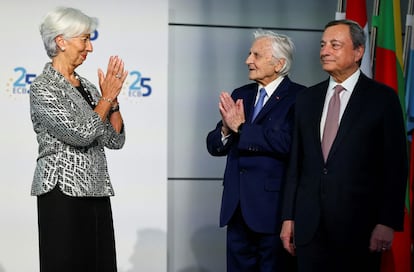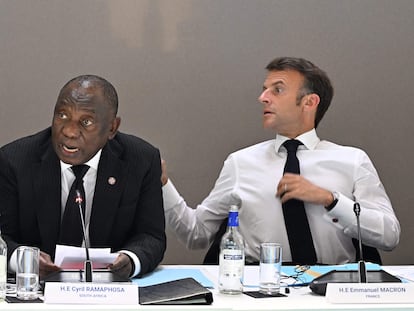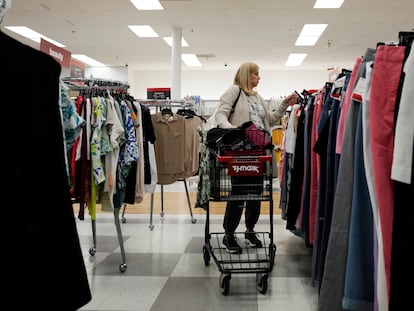Central banks fuel inflation and increase the risk of a crisis
Hawks and doves hammer out their differences at major gathering of the European Central Bank in Sintra, Portugal


Central bankers have redoubled their efforts against inflation, both in word and deed, raising the risk of a full-blown economic recession in the major Western economies. The UK, Switzerland and Norway announced further interest rate hikes on June 22; the eurozone had already done likewise the previous week and the US, after a slight hesitation on June 21, rushed swiftly to clarify that at least two more hikes were in the pipeline.
“There is a long way to go before we bring inflation down to the 2% target,” said US Federal Reserve (Fed) Chairman Jerome Powell in Congress. “Inflation is still very high and we have to deal with it,” said Bank of England Governor Andrew Bailey, having just surprised the market with a rate hike of half a percentage point, bringing it to 5%, when just a quarter point had been on the cards. “Inflation is expected to remain too high for too long,” said European Central Bank President Christine Lagarde.
When prices spiral out of control – and Europe has experienced the worst escalation in 40 years – the typical solution is to raise the price of money to make credit more expensive for companies and households, cooling demand and thus curbing inflation. Today, inflation in the eurozone stands at 6.1%, far from its target of 2%. The question of how much further rates need to be raised, and how fast in order to reach the 2% target, will be under discussion this Monday, June 26, in Sintra, a delightful village in Portugal where the ECB organizes an annual forum for the great patrons of Western monetary policy. On one side of the table will be the hawks with their rigorous view of inflation targets and, on the other, the doves who favor a less orthodox approach.
Internal differences have become increasingly evident within the ECB in recent months. Among those taking the orthodox view is Germany’s Isabel Schnabel, a member of the Eurobank’s Executive Board, who this week made clear which way she swung: “It is better to overdo it [with rate hikes] than to fall short,” she said. Another expert in favor of a rigid approach, Joaquim Nagel, President of the German Bundesbank, said that a further hike in September was probably necessary. Meanwhile French governor François Villeroy, a dove, called for calm. “We are guided by data, not forecasts,” he said.
For the past three years, these forecasts have proved hit and miss thanks to unforeseen events, ranging from the shock of the pandemic to a disruption in the supply chain due to the Russian invasion of Ukraine and the ensuing energy crisis, not to mention the banking turmoil of last March. This weekend, the conflict in Ukraine has entered a new unpredictable phase, following the failed mutiny by the Wagner mercenary group against the Kremlin.
It is not an optimum moment for projections. At their meeting a year ago, bankers were uttering something of a mea culpa for not having acted earlier in the face of a stubborn inflationary trend. ECB President Christine Lagarde launched her own version of “whatever it takes,” popularized by Mario Draghi during the euro crisis, and promised to go “as far as necessary” to tackle inflation that was heading for 10% – which it did, in fact, reach in October. Frankfurt set July 2022 as the first rate hike in more than a decade, an increase of half a percentage point – or 50 basis points – after a long period of negative rates.

Today, eight consecutive rate hikes later, and with the price of money at 4%, the economy has held up to almost everyone’s surprise, with only a hint of a technical recession in the eurozone amounting to a contraction of one tenth of a point for two quarters in a row and a minimal impact on Germany, where unemployment is at historic lows and wages are rising.
Standing steady is core inflation, which excludes the most volatile items such as energy and food, and which is more closely linked to demand dynamics. The year-on-year rate was 5.3%, compared with 5.6% in April, meaning it remains high despite two consecutive months of declines. Frankfurt has raised its inflation forecasts for both the short and medium term by one tenth of a percentage point, which has given the hawks more grist to their mill.
The market takes a new rate hike in July for granted. This will put the price of money at the highest level since 2000. A bet on another hike in September has gained ground with both Goldman Sachs and Bank of America in favor.
De-escalation
“Immaculate disinflation” to reduce price escalation without triggering a crisis has so far seemed possible. This new phase of price containment, however, is more risky because it no longer has to do with softening energy or supply chain shocks, which account for much of the de-escalation achieved to date. Rather it now has more to do with placating demand, which is the driving force of the economy.
The argument for slowing down the hikes, and waiting to see what happens in the coming months, is based on the fact that the fight against inflation depends not only on raising rates beyond 4%, but also on the amount of time they are kept at that level. It also depends on the time lag between when rates are raised and when the real economy feels the impact: Lagarde has admitted that this ranges from between 18 to 24 months, which means that the economic slowdown, which is already beginning to be felt, will enter its most critical phase at the end of this year, as the rate hikes began last July.
Sign up for our weekly newsletter to get more English-language news coverage from EL PAÍS USA Edition
Tu suscripción se está usando en otro dispositivo
¿Quieres añadir otro usuario a tu suscripción?
Si continúas leyendo en este dispositivo, no se podrá leer en el otro.
FlechaTu suscripción se está usando en otro dispositivo y solo puedes acceder a EL PAÍS desde un dispositivo a la vez.
Si quieres compartir tu cuenta, cambia tu suscripción a la modalidad Premium, así podrás añadir otro usuario. Cada uno accederá con su propia cuenta de email, lo que os permitirá personalizar vuestra experiencia en EL PAÍS.
¿Tienes una suscripción de empresa? Accede aquí para contratar más cuentas.
En el caso de no saber quién está usando tu cuenta, te recomendamos cambiar tu contraseña aquí.
Si decides continuar compartiendo tu cuenta, este mensaje se mostrará en tu dispositivo y en el de la otra persona que está usando tu cuenta de forma indefinida, afectando a tu experiencia de lectura. Puedes consultar aquí los términos y condiciones de la suscripción digital.
More information
Archived In
Últimas noticias
Cubans look to Venezuela fearfully after Trump’s incursion: ‘We could be next’
The operation in Venezuela to capture Maduro threatens to widen the cracks in the MAGA movement
Trump clarifies who is ultimately in charge in Venezuela: ‘Me’
Maduro pleads not guilty before the federal court in New York: ‘I am still the president of Venezuela’
Most viewed
- Alain Aspect, Nobel laureate in physics: ‘Einstein was so smart that he would have had to recognize quantum entanglement’
- Gilles Lipovetsky: ‘If you want to live better and fall in love, take Prozac, don’t look to philosophy’
- Alvin Hellerstein, a 92-year-old judge appointed by Bill Clinton, to preside over Maduro’s trial in New York
- Cuba confirms death of 32 of its citizens in the US attack against Venezuela
- Why oil has been at the center of Venezuela-US conflicts for decades










































